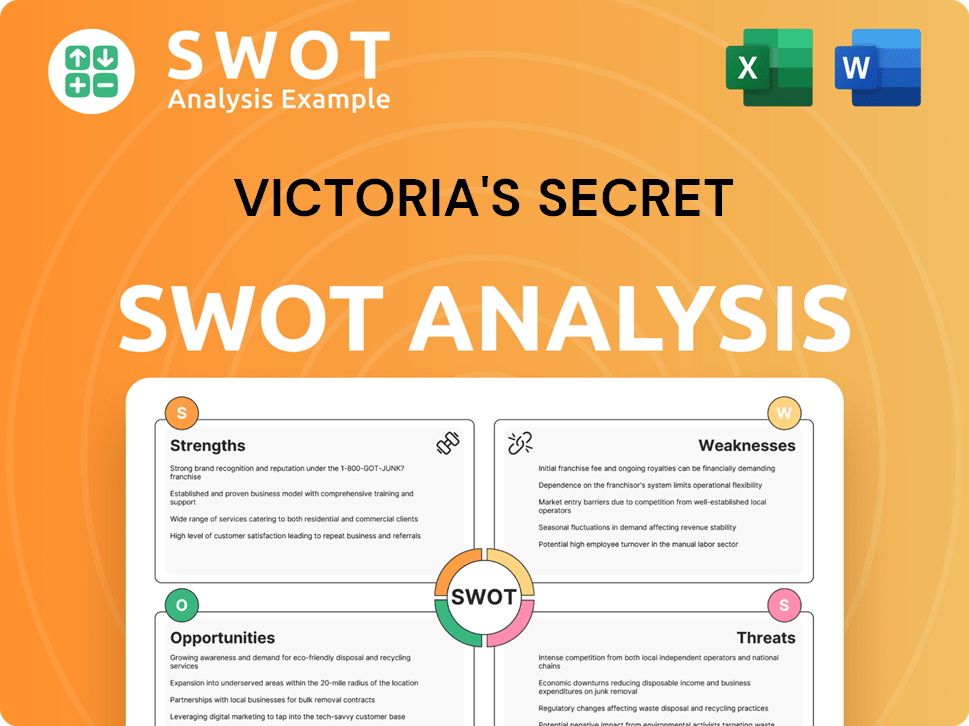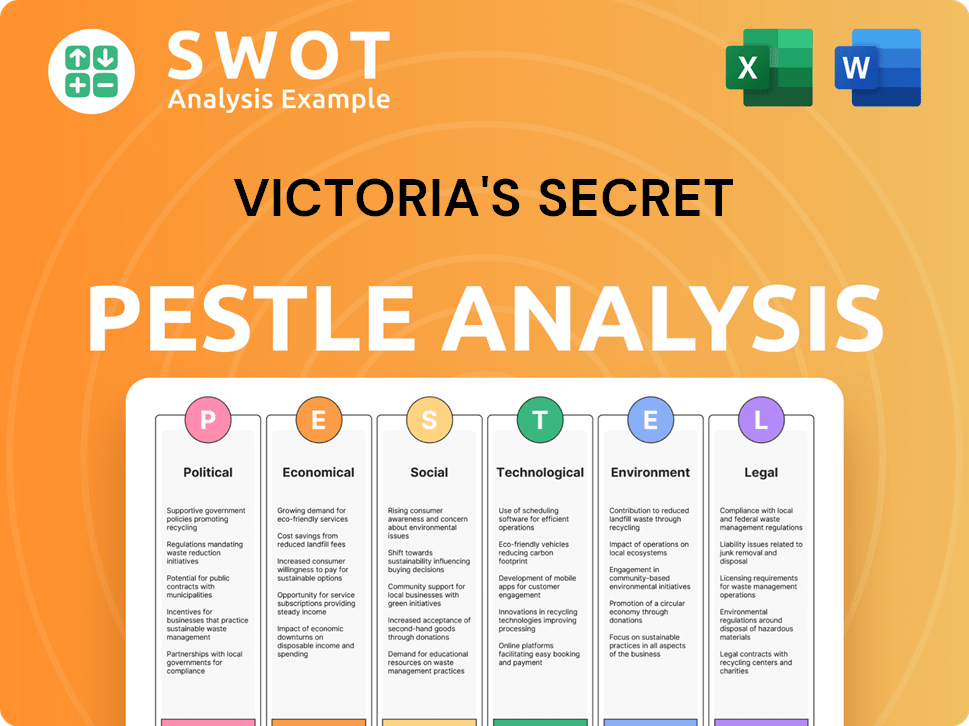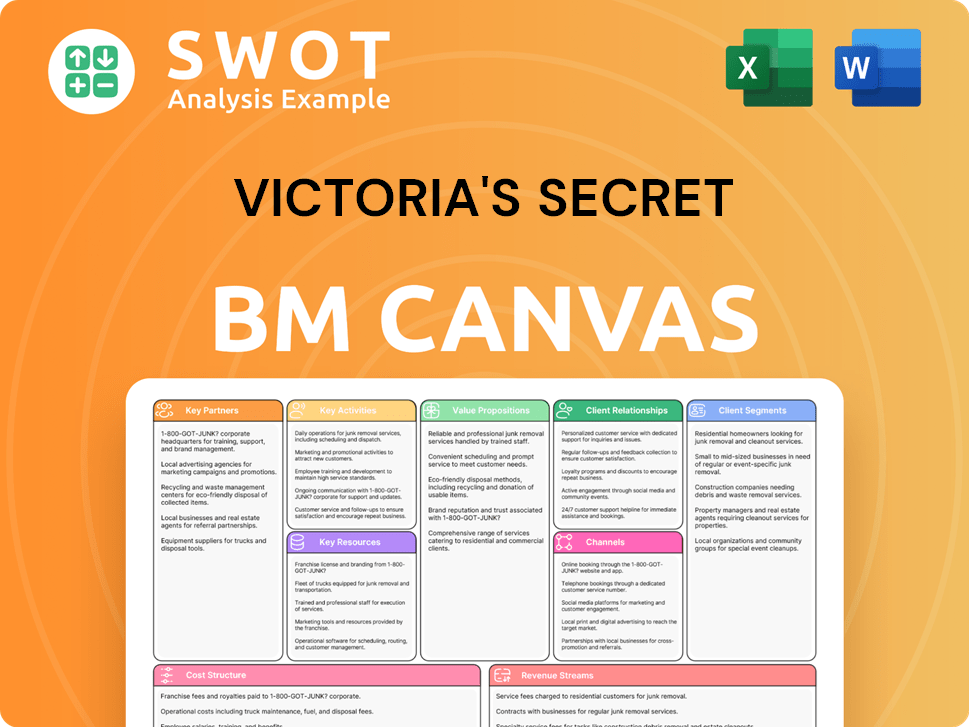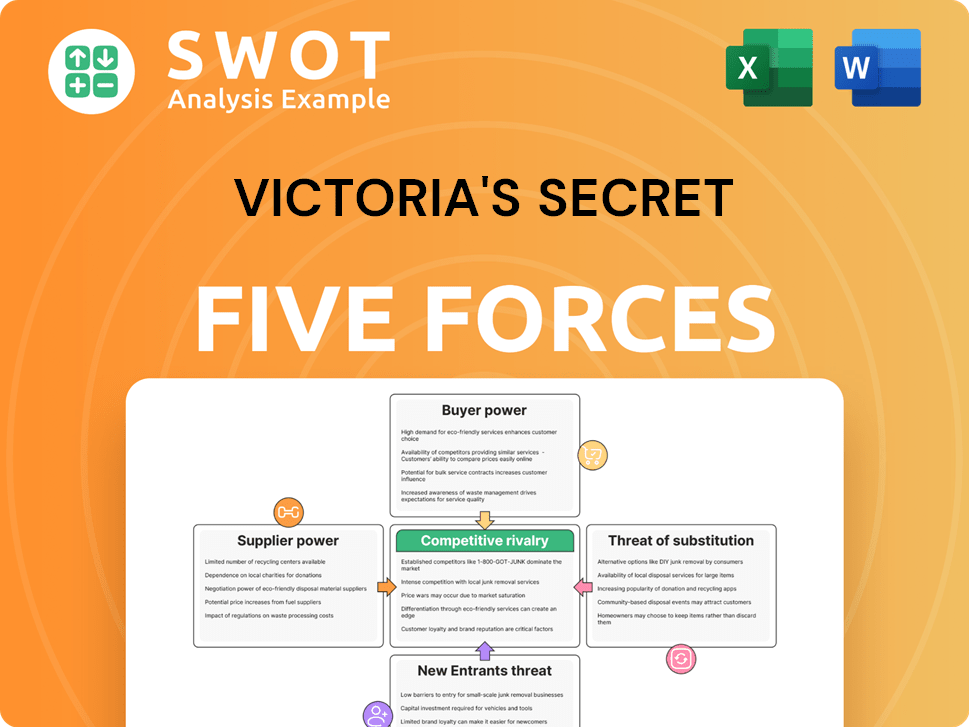Victoria's Secret Bundle
How has Victoria's Secret transformed the American retail landscape?
Step into the world of Victoria's Secret, a brand that once dominated the lingerie industry and redefined marketing with its iconic fashion shows. Founded in 1977, the Victoria's Secret SWOT Analysis reveals a complex history of triumphs and tribulations. From its innovative beginnings to its current standing, the Victoria's Secret company has witnessed significant shifts in consumer behavior and market dynamics.

This exploration into the VS history will uncover the Victoria's Secret brand's evolution, examining its early days and the strategic decisions that propelled it to global recognition. We'll also investigate the factors contributing to its changing fortunes, including the impact of the lingerie industry and the broader trends in American retail. Join us to understand the enduring legacy of this retail giant.
What is the Victoria's Secret Founding Story?
The story of the Victoria's Secret company, a cornerstone in the American retail and lingerie industry, began on June 12, 1977. Roy Raymond, a Stanford Graduate School of Business alumnus, founded the company with a specific vision in mind. This vision aimed to redefine the experience of buying lingerie, a sector ripe for innovation.
Raymond's inspiration for Victoria's Secret history stemmed from his personal experiences. He found the process of shopping for lingerie for his wife in traditional department stores to be uncomfortable and unwelcoming. This led him to conceive a retail space that would cater to both men and women, offering a more pleasant and less intimidating shopping environment. His goal was to create a sophisticated and tasteful experience, setting the stage for the Victoria's Secret brand.
The initial concept of Victoria's Secret revolved around providing a boutique-like atmosphere for high-quality lingerie. The first store opened at the Stanford Shopping Center in Palo Alto, California, marking the beginning of its journey.
- The initial funding for the company was a mix of a $40,000 bank loan and $40,000 borrowed from Raymond's parents, totaling $80,000.
- The name 'Victoria's Secret' was chosen to evoke the elegance of the Victorian era, hinting at an intimate secret.
- Raymond aimed to establish a niche market for intimate apparel that was distinct from existing offerings.
- His business background provided the framework for his innovative retail concept.
The early days of Victoria's Secret saw Raymond facing the challenge of establishing a distinct presence in the lingerie market. The brand's name and concept were carefully chosen to reflect a sense of classic luxury and sophistication, setting it apart from competitors. The company's focus on creating a customer-centric shopping experience was a key element of its early strategy. More details about the company's evolution can be found in this comprehensive resource on the history of Victoria's Secret.
Victoria's Secret SWOT Analysis
- Complete SWOT Breakdown
- Fully Customizable
- Editable in Excel & Word
- Professional Formatting
- Investor-Ready Format

What Drove the Early Growth of Victoria's Secret?
The early growth of the Victoria's Secret company marked a pivotal phase in the evolution of the Victoria's Secret brand. The initial concept quickly gained traction, leading to rapid expansion in its early years. This period set the stage for the brand's transformation into a dominant force in the American retail landscape.
Following the success of its first store, the company opened two more stores in the San Francisco Bay Area. In 1979, the launch of a mail-order catalog was a key move, broadening its reach beyond physical locations. This catalog significantly contributed to early sales, allowing the brand to connect with customers beyond its immediate geographical footprint.
The initial product range focused on luxurious, European-inspired lingerie, sleepwear, and intimate accessories. This differentiated the brand from more functional lingerie industry offerings available at the time. The early concept aimed to create a unique shopping experience, setting the stage for future brand identity and marketing strategies.
In 1982, after five years of operation, the founder sold the company to Leslie Wexner of Limited Brands for approximately $1 million. At the time of the sale, the company had six stores and a 42-page catalog. This change in ownership marked a crucial turning point in the VS history.
Under Wexner's leadership, the brand underwent a significant strategic shift, broadening the product assortment and introducing more affordable lines. The marketing focus changed to directly appeal to women, transforming stores into welcoming environments. This pivot was instrumental in the evolution of Victoria's Secret brand.
Victoria's Secret PESTLE Analysis
- Covers All 6 PESTLE Categories
- No Research Needed – Save Hours of Work
- Built by Experts, Trusted by Consultants
- Instant Download, Ready to Use
- 100% Editable, Fully Customizable

What are the key Milestones in Victoria's Secret history?
The Victoria's Secret history is marked by several significant milestones that shaped its trajectory in the American retail and lingerie industry. These events highlight the brand's evolution and its impact on the market.
| Year | Milestone |
|---|---|
| 1977 | The first store opened in San Francisco, offering lingerie in a Victorian-inspired setting. |
| 1982 | The company was acquired by Limited Brands, which fueled its expansion across the United States. |
| 1995 | The Victoria's Secret Fashion Show debuted, transforming lingerie into a major entertainment event. |
| 2004 | The PINK brand was launched, targeting a younger demographic with casual apparel. |
| 2021 | Victoria's Secret & Co. was spun off from L Brands, marking a new chapter in its corporate structure. |
Innovations played a crucial role in the evolution of the Victoria's Secret brand. These innovations helped shape its identity and market position within the lingerie industry.
The annual Victoria's Secret Fashion Show, starting in 1995, was a groundbreaking innovation. It transformed lingerie into a high-profile entertainment spectacle, significantly boosting the brand's global recognition and sales.
Expanding into fragrances and beauty products was a strategic move. This expansion created a comprehensive lifestyle brand, extending beyond intimate apparel and increasing revenue streams.
The launch of PINK in 2004 was a key innovation. It targeted a younger demographic with more casual and comfortable apparel, broadening the brand's appeal.
Despite its successes, the Victoria's Secret company has faced several challenges. These challenges have forced the brand to adapt to changing consumer preferences and market dynamics.
The brand faced criticism for its narrow beauty standards. This led to a decline in brand relevance and sales, as consumers sought more inclusive options.
The rise of direct-to-consumer (DTC) brands that championed inclusivity and body positivity impacted sales. The cancellation of the Fashion Show in 2019 signaled a strategic shift.
The company embarked on a significant rebranding effort after the spin-off in August 2021. This included new leadership and marketing campaigns featuring diverse models.
Victoria's Secret Business Model Canvas
- Complete 9-Block Business Model Canvas
- Effortlessly Communicate Your Business Strategy
- Investor-Ready BMC Format
- 100% Editable and Customizable
- Clear and Structured Layout

What is the Timeline of Key Events for Victoria's Secret?
The Victoria's Secret history is marked by significant milestones, from its inception in 1977 by Roy Raymond to its evolution into a major player in the American retail and lingerie industry. The company's journey includes rapid expansion, the iconic fashion shows, and strategic shifts in response to changing consumer preferences. The brand has undergone ownership changes, faced controversies, and adapted its marketing strategies over the years, reflecting the dynamic nature of the retail landscape and the lingerie industry.
| Year | Key Event |
|---|---|
| 1977 | Roy Raymond founded Victoria's Secret in San Francisco, California. |
| 1982 | Leslie Wexner of Limited Brands acquired Victoria's Secret. |
| 1995 | The first Victoria's Secret Fashion Show was held, becoming an annual event. |
| 2000 | Victoria's Secret launched its e-commerce website. |
| 2004 | The PINK brand was launched, targeting a younger demographic. |
| 2019 | The Victoria's Secret Fashion Show was officially canceled. |
| 2021 | Victoria's Secret & Co. (VS&Co) spun off from L Brands and became an independent publicly traded company. |
| 2024 | Victoria's Secret & Co. reported net sales of $6.181 billion for fiscal year 2023, ended February 3, 2024. |
Victoria's Secret is focused on modernizing its brand image to align with evolving consumer values. This includes a greater emphasis on inclusivity, body diversity, and a more empowering message. The company is also working to strengthen its core categories and expand into new product areas. These efforts are designed to resonate with a broader audience and ensure long-term relevance in the lingerie industry.
The company is investing heavily in digital platforms to enhance the customer experience and drive e-commerce sales. This includes improving its website, mobile app, and online marketing efforts. Digital transformation is seen as critical for reaching a wider audience and providing personalized shopping experiences. This strategic focus is aimed at increasing online sales and customer engagement.
Victoria's Secret is exploring new geographic markets and strengthening its franchise partnerships. The company is aiming to expand its international footprint, particularly in key markets. This expansion strategy is expected to drive revenue growth and increase brand visibility worldwide. The company continues to adapt its strategies to local market preferences.
The lingerie industry is influenced by increasing demand for sustainable fashion, personalized shopping experiences, and a greater emphasis on diversity and inclusion. The company is likely to continue to adapt its strategies to these trends. Analyst predictions suggest a continued focus on profitability and market share in a competitive landscape. The company is aiming to innovate and adapt to consumer preferences.
Victoria's Secret Porter's Five Forces Analysis
- Covers All 5 Competitive Forces in Detail
- Structured for Consultants, Students, and Founders
- 100% Editable in Microsoft Word & Excel
- Instant Digital Download – Use Immediately
- Compatible with Mac & PC – Fully Unlocked

Related Blogs
- What is Competitive Landscape of Victoria's Secret Company?
- What is Growth Strategy and Future Prospects of Victoria's Secret Company?
- How Does Victoria's Secret Company Work?
- What is Sales and Marketing Strategy of Victoria's Secret Company?
- What is Brief History of Victoria's Secret Company?
- Who Owns Victoria's Secret Company?
- What is Customer Demographics and Target Market of Victoria's Secret Company?
Disclaimer
All information, articles, and product details provided on this website are for general informational and educational purposes only. We do not claim any ownership over, nor do we intend to infringe upon, any trademarks, copyrights, logos, brand names, or other intellectual property mentioned or depicted on this site. Such intellectual property remains the property of its respective owners, and any references here are made solely for identification or informational purposes, without implying any affiliation, endorsement, or partnership.
We make no representations or warranties, express or implied, regarding the accuracy, completeness, or suitability of any content or products presented. Nothing on this website should be construed as legal, tax, investment, financial, medical, or other professional advice. In addition, no part of this site—including articles or product references—constitutes a solicitation, recommendation, endorsement, advertisement, or offer to buy or sell any securities, franchises, or other financial instruments, particularly in jurisdictions where such activity would be unlawful.
All content is of a general nature and may not address the specific circumstances of any individual or entity. It is not a substitute for professional advice or services. Any actions you take based on the information provided here are strictly at your own risk. You accept full responsibility for any decisions or outcomes arising from your use of this website and agree to release us from any liability in connection with your use of, or reliance upon, the content or products found herein.